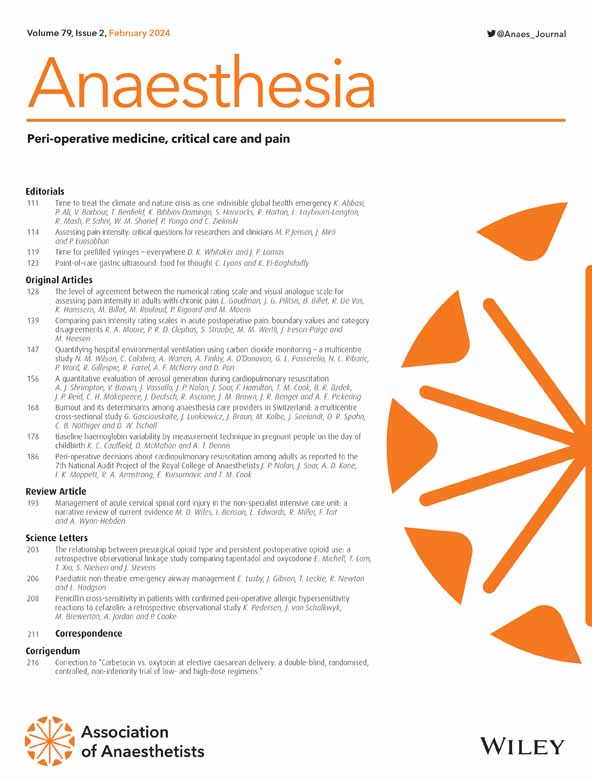麻醉师协会指南:安全血管通路2025。
IF 6.9
1区 医学
Q1 ANESTHESIOLOGY
引用次数: 0
摘要
安全的血管通路是麻醉和重症监护实践不可或缺的一部分。然而,尽管技术和程序进步,它仍然是不良事件和患者伤害的常见来源。确保安全有效地选择、插入和护理血管通路装置应该是所有从业人员的优先事项。方法:这一更新的共识声明建立在先前安全血管通路指南的基础上。一个多学科、多社会的专家工作组就主要主题达成一致,并对文献和最佳做法进行了审查,以建立一个全面的工作体系。随后进行了两轮德尔菲程序,以商定具体建议并为这些简明指导方针提供信息。结果我们成功达成了15项建议,包括操作、培训和临床问题,重点是血管通路和长期血管健康的整体方法。这些建议分为六个主题,包括:过程(血管准入小组和反应能力关键绩效指标);设备选择;插入,包括使用安全标准、超声、导管尖端位置和静脉/导管比例;抗凝治疗、导管相关血栓形成和凝血疾病的管理;特定的患者群体,包括需要肾脏替代治疗的患者,乳房切除术和腋窝淋巴结切除术后和使用外周血管收缩剂;以及高级血管通路的训练。希望这些指南,连同更大的工作,将改善需要血管通路的患者的护理,嵌入血管通路和终身静脉保存的更全面的方法,并支持血管通路服务的工作人员和医院的发展。本文章由计算机程序翻译,如有差异,请以英文原文为准。
Association of Anaesthetists guidelines: safe vascular access 2025.
INTRODUCTION
Safe vascular access is integral to anaesthetic and critical care practice. However, despite technological and procedural advances, it remains a frequent source of adverse events and patient harm. Ensuring a safe and effective approach to the selection, insertion and care of vascular access devices should be a priority for all practitioners.
METHODS
This updated consensus statement builds upon previous iterations of safe vascular access guidelines. An expert, multidisciplinary, multi-society working party agreed on major themes and conducted a review of literature and best practice to build a comprehensive body of work. This was followed by a two-round Delphi process to agree on specific recommendations and to inform these concise guidelines.
RESULTS
We agreed successfully 15 recommendations encompassing operational, training and clinical issues with an emphasis on a holistic approach to vascular access and long-term vessel health. These recommendations were divided into six major themes, covering: process (vascular access teams and responsiveness key performance indicators); device selection; insertion, including the use of safety standards, ultrasound, catheter tip position and vein/catheter ratios; the management of anticoagulation therapy, catheter-related thrombosis and coagulopathies; specific patient groups, including patients requiring renal replacement therapy, following mastectomy and axillary lymph node resection and the use of peripheral vasoconstrictors; and training in advanced vascular access.
DISCUSSION
It is hoped that these guidelines, together with the larger body of work, will improve the care of patients who require vascular access, embed a more holistic approach to vascular access and lifetime vein preservation, and support staff and hospitals with vascular access service development.
求助全文
通过发布文献求助,成功后即可免费获取论文全文。
去求助
来源期刊

Anaesthesia
医学-麻醉学
CiteScore
21.20
自引率
9.30%
发文量
300
审稿时长
6 months
期刊介绍:
The official journal of the Association of Anaesthetists is Anaesthesia. It is a comprehensive international publication that covers a wide range of topics. The journal focuses on general and regional anaesthesia, as well as intensive care and pain therapy. It includes original articles that have undergone peer review, covering all aspects of these fields, including research on equipment.
 求助内容:
求助内容: 应助结果提醒方式:
应助结果提醒方式:


